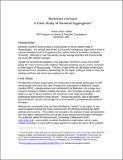Berkshire Connect: A Case Study of Demand Aggregation
Author(s)
Gillett, Sharon
DownloadBerkshire_Connect.pdf (30.20Kb)
Metadata
Show full item recordAbstract
Berkshire County is home to about 135,000 people on the far western edge of
Massachusetts. It is perhaps best known as the scenic mountainous region that is home to
cultural institutions such as Tanglewood (the summer home of the Boston Symphony
Orchestra). Although a rural, low-density county, average education and income levels
are on par with national averages.
Despite the favorable demographics of its population, Berkshire County found itself
facing the "new" economy with mediocre telecommunications service choices compared
to other regions of Massachusetts. The lack of state-of-the-art, affordable infrastructure
was perceived as a competitive disadvantage for the region, making it harder to retain the
existing workforce and attract new employers to the region.
The Berkshire Connect project grew out of discussions that started taking place in 1997
among people who knew each other through their participation in Berkshire Capital
Investors (BCI), a private venture fund contributed to by Berkshire Life (a large local
insurance company), Williams College and others. BCI had begun funding dot-coms,
partly as a way to attract professors and executives to the region by providing
professional opportunities to their spouses. Through this process, lack of affordable
telecom/datacom services had emerged as an issue hindering entrepreneurial activity in
the region.
Date issued
2002-07-22Keywords
demand aggregation, Berkshire Connect, competitive disadvantage, infrastructure, affordable telecom